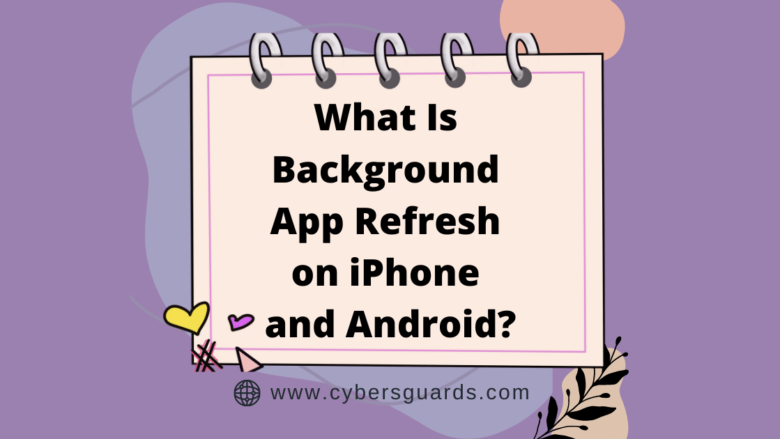What does background app refresh imply, and how does it work? On iPhone and Android, this is how it works.
Both iPhone and Android phones include a feature called background app refresh. If you’ve come across this term and aren’t sure what it means, we’re here to help.
Let’s take a look at what background app refresh is, what it does, and how you may adjust it.
What Is App Refresh in the Background?
Background app refresh is an iOS and Android feature that allows apps to get content from the internet even while you aren’t using them. When you launch and use apps, however, we say that data is used in the foreground.
Background app refresh is beneficial since it makes using apps more seamless, but it also has certain disadvantages.
What is the purpose of Background App Refresh?
Background refresh allows apps to execute a variety of tasks in the background that would otherwise need you to keep the app open. But what exactly does background app refresh do? Here are some instances of actions it can perform without you needing to check them manually:
- When you open a news app, it will be updated with the most recent headlines.
- Apps that monitor your mobile data usage gather data in the background.
- Cloud storage providers automatically sync your files.
- When you enter a store, the app recognises you and pulls up the most recent digital coupons.
Twitter and other social media applications preload the most recent tweets so you don’t have to wait for them when you access them.
It’s worth noting that if you close apps from the app switcher, they might not update until you open them again. This is just one of the numerous reasons why you shouldn’t keep swiping to close all of your apps.
It’s also worth noting that background app refresh does not effect notifications in most iPhone apps. This means you may turn off the feature for messengers like WhatsApp and still receive notifications when new messages arrive. This isn’t the case with Android, as we’ll discover shortly.
Is it necessary to use Background App Refresh?
Background app refresh is usually convenient. There are two main reasons why you would want to disable it.
The first is that background app refresh is enabled by default on both mobile data and Wi-Fi connections. Apps can consume a lot of data in the background, which can result in unexpected costs on your bill if you have a limited data plan.
The ability to save battery life is another reason to disable background app refresh. Background apps use the same amount of battery as apps that are running in the foreground. You don’t want to waste power on background processes if you want your device to survive as long as possible between charges.
It’s entirely up to you which apps need to be refreshed in the background. In general, keep it enabled for apps you use frequently and disable it for programmes you only use sometimes.
Both Android and iOS allow you to disable and customise background app refresh. Let’s look at how to do it.
How to Turn Off iPhone Background App Refresh?
Go to Settings > General > Background App Refresh to modify which apps run in the background on your iPhone. You’ll see a list of apps that employ background app refresh on your iPhone here.
Simply disable an app’s slider, and it will stop updating in the background. To go online and check for new information, you’ll need to launch the app. If you’re using an app that relies on current content, be cautious.
To customize how the feature operates worldwide, tap the Background App Refresh box at the top. Apps will refresh on any network if you have Wi-Fi & Cellular Data enabled. If you don’t want apps to check for fresh information when using mobile data, use Wi-Fi instead, which is a good option if your cellular plan is restricted.
You can also choose Off to prevent your iPhone’s apps from refreshing in the background. This will save battery life, but it will also make apps less functional, so proceed with caution.
iPhone Low Power Mode and Cellular Access
There are two other iPhone choices connected to background app refresh that you should be aware of.
The first is Low Power Mode, which limits your iPhone’s processes in order to conserve battery life. It’s accessible through Settings > Battery or the Control Center shortcut.
When you enable Low Power Mode, your iPhone dims the screen, stops email push, and fully eliminates background app refresh. If you only need to save battery life for a short period, it’s therefore more convenient to use Low Power Mode rather than off background app refresh. Background refresh will resume when you disable Low Power Mode.
Finally, you may disable the slider for any app that doesn’t wish to use cellular data in the Settings > Cellular menu. This is an excellent approach to prevent data-hungry apps from using too much data when utilising background app refresh, while still allowing other apps to use the feature even when using mobile data.
How to Disable Android Background App Refresh?
This is an iPhone word; Android does not have a feature called “background app refresh.” Android, on the other hand, has alternatives that perform nearly the same job. The position and name of the option will differ depending on your device; the steps below are for vanilla Android 12 on a Pixel phone.
To stop an app from using mobile data in the background, go to Settings > Apps (Apps & notifications on previous versions) > Disable background data usage. View all X applications. Tap the app you wish to disable background app refresh for in the list.
You have two options for disabling background activities in Android from this menu. Select Mobile data & Wi-Fi and disable the Background data slider to prevent the app from using your cellular data in the background.
Unless you’re using the app in the foreground, it won’t use mobile data. When using Wi-Fi, background use is unaffected.
Another alternative is to disable the programme from operating in the background altogether. To do so, go to the app’s settings page and tap Battery (with Android 11 and older, it’s under the Advanced section).
To prevent the programme from taking too much power in the background on Android 11 and older, touch Background restriction, then Restrict. On Android 12, select Restricted from the menu.
This affects alerts, unlike the iPhone’s background app refresh feature. As a result, you should limit battery usage to apps that do not require real-time notifications.
Android’s Account Sync, Battery Saver, and Individual App Options
There are a couple other alternatives for background app refresh on Android that you should be aware of.
All of your synchronised internet accounts are kept on a separate tab in Android’s Settings. To see them, go to Settings > Accounts (or Passwords & Accounts on Android 12). To check and change what syncs, tap an account and select Account sync. For example, you might be able to prevent the service from constantly syncing your contacts, files, and other data.
Disable the Automatically sync app data slider at the bottom of the main screen for a more extreme move. Accounts will only sync if you manually reload the page.
Under Settings > Battery, most Android phones offer a feature named Battery Saver or something similar. Enabling Battery Saver works similarly to iPhone’s Low Power Mode in that it prevents apps from running in the background to save battery life. You might also have an Adaptive battery setting, which regulates how much power your apps consume according on how often you use them.
Finally, if none of the preceding solutions prevented background app refresh in the way you wanted, it’s worth looking into the individual app settings. Many programmes allow you to customise how frequently your feed syncs, new emails are fetched, and other features. You might be able to disable the one app behaviour you don’t use.
Background App Refresh is now clear to you.
While background app refresh differs across iPhone and Android, it’s a useful feature that keeps apps current even when you’re not using them. While this is useful most of the time, you now know how to disable background refresh to avoid apps from using too much power or mobile data in the background.
It’s unfortunate that smartphones have such a limited battery life when compared to other gadgets, but there are techniques to extend it.










FIND US ON SOCIALS